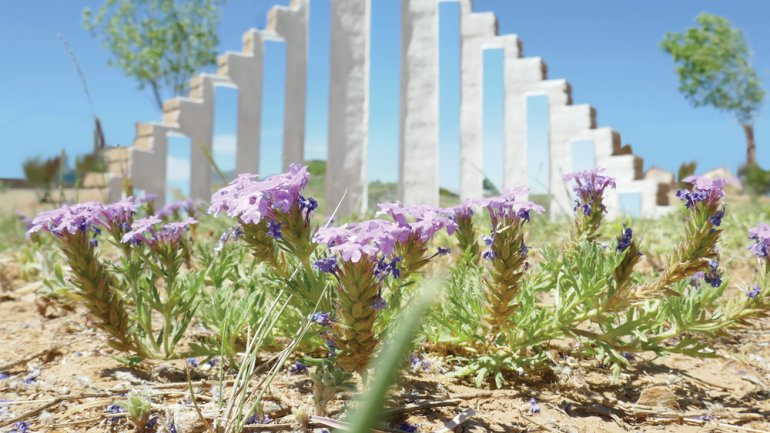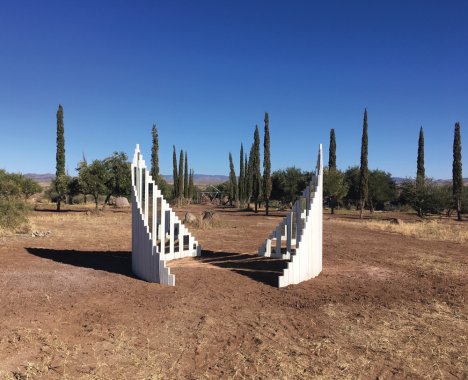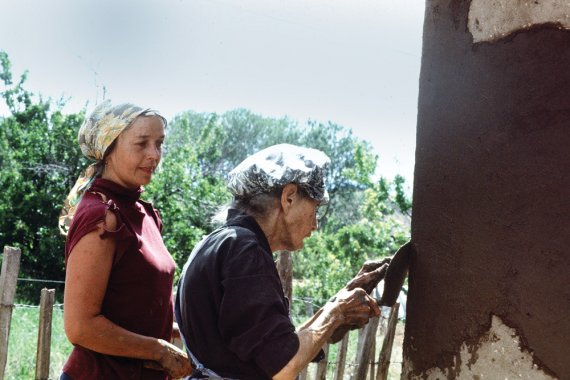Legacy of the Land
Legacy of the Land
Beneath a wide blue New Mexico sky, a woman mixes earth and clay with binding elements such as straw, silt, and sand to make adobe mud. She molds it into bricks that she leaves out to bake in the sun. The bricks are stacked to form adobe walls for a home or maybe a community building or a place of worship, but it isn’t yet complete. The woman spreads earthen plaster (a smoother mix of the adobe ingredients) over the walls to even the surface, fill in cracks, and seal out the elements. On the interior, she paints alíz, a slip made of caliche (a fine clay) and a binding agent such as buttermilk or wheat paste, transforming the brown plaster into a warm white. Her work finishes the space so it feels ready for living.
The woman is an enjarradora, a female plasterer in the adobe architectural tradition of the American Southwest. Today, only a handful of women devote their lives to the craft. Among them is Joanna Keane Lopez, a 28-year-old Albuquerque artist and student of enjarradora Anita Rodríguez and natural builder Carole Crews.
Keane Lopez sees dynamism in the traditional language of adobe and uses it to make new meaning. She’s painted with alíz and framed photos with earthen materials. And she builds, plasters, and finishes site-specific sculptures – triangular, standalone adobe walls that rise from the desert earth in gentle curves, affixed with mirrors that reflect the landscape.
With her art practice comes a deep awareness that the history of adobe in the Southwest is tied to the story of its mixed Indigenous and Latinx community, from the scars of past colonialism to its strength in diverse cultures today. Along with themes drawn from her personal life, Keane Lopez says her work “takes on this quality of being an echo, a ghost, a memory of land-based lifestyles, something lost and fragmented and reaching to recover or reconnect, or to find some inkling of continuity.”
The spaces formed by her walls and installations are intimate, but they are intentionally open and accessible to the public for gathering and performance. And because the adobe process can require many hands, Keane Lopez frequently invites the community to help out, in turn teaching them by showing and doing, just as her teachers showed her – and just as those women learned from the previous generation. We spoke about these themes, and the many ways adobe is a connective force and reparative medium in fractured places.
When people think about the Southwest, they often picture the beautiful adobe homes of New Mexico, but few are familiar with the role of the enjarradoras in creating that architectural landscape.
“Enjarradora” comes from the Spanish verb “enjarrar,” which means “to plaster.” And so “enjarradora” is, literally, “woman plasterer.”
But it’s more than just plastering mud on adobe walls. It’s an extensive practice that I’m continuing to understand and learn about. Along with plastering, it’s laying mud floors, filling in cracks on the walls and doing repairs. It’s building the adobe fireplaces and hornos [outdoor ovens]. It’s everything that has to do with the beautifying aspects of building an adobe home, both inside and outside. Basically, it’s the creative practice of a woman working with adobe architecture.
The practice goes back generations.
Yes, it’s passed from one woman to another, from family member to family member, from neighbor to neighbor, friend to friend. It’s this practical, creative practice of an intimate relationship between home and land that has traveled across generations.
I love how Tewa Pueblo artist Nora Naranjo Morse describes an adobe home as “a vessel for living.” She draws a beautiful connection between adobe architecture and pottery.
I’ve always loved ceramics, and adobe is like working with ceramics, but in this very large way. Instead of a kiln, it’s fired by the sun.
It’s interesting to lay these bricks, plaster the mud, and paint it with alíz or a lime wash; it’s a sculpture. What I’m interested in is how to bring together this earthen architectural practice with contemporary sculpture. I want to continue a relationship and conversation about land through adobe – a medium whose nature is ultimately ephemeral or temporal.
You learned aspects of the practice from Anita Rodríguez and Carole Crews by assisting them with the upkeep of adobe buildings, including their self-built homes. In addition to making repairs and mixing materials, your education involved harvesting materials.
With Anita, we even collected off the highway, down the road from where she lives. Materials can literally be right down the road, if you have the eye and know what to look for.
You can see veins of the caliche clay, a creamy white color. There are certain places that are really special. I’ve heard of a cave in the Taos area of New Mexico where there’s this beautiful lavender caliche with natural mica that makes it sparkle.
Anita and Carole are both heroes of mine. I’m extremely impressed with both of them, as artists and builders and as human beings. Adobe is such a powerful material for a woman to be working with, especially given that the construction industry is male dominated. I feel like there’s an aspect of power and also of grounded-ness in being outside and building big.
And also, the fact that it’s working with earth. You see the earth rise up above you, and it can shelter you. It can create spaces. You can smell it, and there’s this palpable feeling of the rough brown skin of the material, of mud.
Seeking out and mixing the material is very visceral from beginning to end. And it’s a tremendous amount of work.
There can be people who do this alone, but I believe it is a communal and group practice. Within my art practice, I definitely have people come and help me and learn from me. Also, I try to meet other people who work in these practices and learn from them. It’s very “This is what my grandpa did; this is what my neighbor showed me.” It’s great living only a few hours from knowledgeable people like Anita and Carole – and other women such as Helen Levine from New Mexico Earth Adobes, and even the occasional viejito [old man] down the street, who built his own house. It’s all contributing to the knowledge and stories of creating homes and spaces in relationship with land.
That’s been one of the cool things. Sometimes, when building these projects, an elder comes and is totally delighted to see someone younger working with these materials. They tell me their stories.
You explore the matrilineal role of enjarradoras in your art.
It’s not like I just learned these skills out of nowhere; I learned them from other women. They are something that has been handed down.
Your father’s family also built an adobe home, where they lived for generations.
Yes. My great-great-grandfather Rafael López y Luna and his wife, Pablita, are the ones who originally built it, and from there, different family members added on.
It’s still on family land known as Lopezville in Socorro, New Mexico, along with the rest of the old land grant. It used to be quite large during a time I never knew. It stretched all the way to the mountain, but over generations, different parts were sold off. My father, Damacio, owns the historic family house outright, but otherwise, after my grandma Adelina died, Lopezville has been on a steep decline.
A large part of my art practice revolves around the concept of the home, but ultimately, it also wrestles with the reality of the fragmentation and dissolution of family, home, community, and land. And that is a part of my own story, how secrets and trauma, lost dreams, incarceration, estrangement, and alcohol and drug abuse can affect a family, make it fragment and fall apart.
You say adobe is something you have a relationship with.
Because it’s an organic material, it shows whether or not you’re maintaining a relationship of care and continuation. I am really interested in this aspect of a sustained relationship. I don’t mean to say that adobe structures need to be perfectly preserved. I think it is also interesting to see projects starting to crack or the color beginning to fade away just because they’re exposed to the rain, snow, and hail. You can see this fundamental material returning to the earth due to its ephemeral and changeable nature.
To learn more about adobe practice in New Mexico, visit Adobe in Action, a nonprofit supporting owner-builders of adobe homes, and Cornerstones, a nonprofit dedicated to preserving the architectural heritage and cultural traditions of the region.





